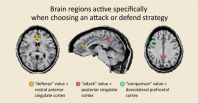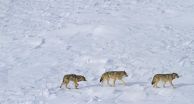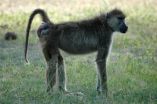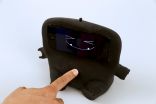A 'cingular' strategy for attack and defense
2015-04-20
(Press-News.org) We often make quick strategic decisions to attack an opponent or defend our position, yet how we make them is not well understood. Now, researchers at the RIKEN Brain Science Institute in Japan have pinpointed specific brain regions related to this process by examining neural activity in people playing shogi, a Japanese form of chess. Published in Nature Neuroscience, the study shows that two different regions within the cingulate cortex--one toward the front of the brain and the other toward the back--separately encode the values of defensive and offensive strategies.
Like a tennis player who makes split-second decisions to either approach the net or back up, decisions to attack or defend are often made before we can evaluate all our options. Continuing their research into how our brains guide intuitive thinking, the team led by Keiji Tanaka investigated these types of rapid strategic decisions using functional magnetic resonance imaging. As this technique requires people to be still, the team focused on shogi--a game that also has moves that can be clearly categorized as offensive or defensive--and measured brain activity while high-level amateur players quickly decided the optimal strategy--attack or defend--after viewing specific board configurations.
As an experimental control, half the time players were told to attack or defend, and did not have to make the decision themselves. Instead, they were asked to choose the best possible move from a short list. This manipulation allowed researchers to separate brain activity related to decisions about what move to make from those related to which strategy to take.
They found that three brain regions were more engaged when choosing the optimal strategy than when choosing the best move once a strategy was given. Tanaka notes, "We were surprised that the brain activity in two regions depended on which strategy was chosen. Choosing to attack," he added, "was associated with greater activity in posterior cingulate cortex, while choosing to defend was associated with activity in the rostral anterior cingulate cortex." They also found that the dorsolateral prefrontal cortex was equally active for both strategies.
Further statistical analysis showed that the activity in these regions was actually related to the offensive and defensive strategy values of the board configurations, not simply the ultimate decision to attack or defend. When researchers calculated the value of attacking or defending in each case, they found that the amount of activity in the rostral anterior cingulate cortex correlated with the defense value and that activity in the posterior cingulate cortex simultaneously correlated with the attack value. They also found that dorsolateral prefrontal cortical activity correlated with the difference between attack and defense values, indicating a possible role in comparing these values and directing the ultimate decision.
Researchers next looked at how well the players performed. They found that people were much better at choosing the optimal strategy than they were at choosing the best move, and that making the strategic decisions took considerably less time.
The quickness and accuracy of strategic decisions, and the correlation of brain activity with attack/defend values indicate that when high-level amateur shogi players choose to go on the offensive or defensive, they do so in response to a heightened perceptual awareness of the pieces on the board--their intuition--and not after reasoning out the best moves. Tanaka reflects that, "Understanding the neural basis for these types of strategic decisions can help researchers develop better models for intuitive thinking. This knowledge could have several applications, such as guiding decision-making in sophisticated artificial intelligence."
INFORMATION:
Wan X, Cheng K, Tanaka K (2015). Neural encoding of opposing strategy values in anterior and posterior cingulate cortex. Nature Neuroscience. DOI: 10.1038/nn.3999
[Attachments] See images for this press release:

ELSE PRESS RELEASES FROM THIS DATE:
2015-04-20
Large amounts of methane - whether as free gas or as solid gas hydrates - can be found in the sea floor along the ocean shores. When the hydrates dissolve or when the gas finds pathways in the sea floor to ascend, the methane can be released into the water and rise to the surface. Once emitted into the atmosphere, it acts as a very potent greenhouse gas twenty times stronger than carbon dioxide. Fortunately, marine bacteria exist that consume part of the methane before it reaches the water surface. Geomicrobiologists and oceanographers from Switzerland, Germany, Great Britain ...
2015-04-20
New apps developed for children come online every day and many of them are marketed or labeled as "educational" - but how can we tell which of these thousands of apps will actually help children learn? A comprehensive new report published in Psychological Science in the Public Interest, a journal of the Association for Psychological Science, integrates research from scientific disciplines like psychological science, linguistics, and neuroscience to provide an evidence-based guide that parents, educators, and app designers alike can use to evaluate the quality of so-called ...
2015-04-20
HANOVER, N.H. - Although the media often portray the Arctic as a new "Great Game" ripe for conflict, a group of international Arctic experts co-chaired by Dartmouth College released recommendations today aimed at preserving the polar north as an area for political and military cooperation, sustainable development and scientific research.
The report, which addresses the priorities of the Arctic Council, an intergovernmental forum of the eight nations that border the polar region, resulted from meetings at the Carnegie Endowment for International Peace in Washington, ...
2015-04-20
Only three wolves seem to remain in Isle Royale National Park. Researchers from Michigan Technological University observed the wolves during their annual Winter Study, and the lone group, at an unprecedented low, is a sharp decline from nine wolves observed last winter.
The study's report, released today, marks the project's 57th year of observing wolves and moose in Isle Royale. It is the longest running predator-prey study in the world. This year, along with the three resident wolves, scientists estimated 1,250 moose on the island and observed two visiting wolves, ...
2015-04-20
Massachusetts General Hospital (MGH) investigators have found the probable mechanism underlying a previously described biomarker associated with the risk of developing serious diseases ranging from cancer to cardiovascular disease and the risk of serious complications. In a paper published in the American Journal of Hematology, the research team reports finding that higher levels of a measure routinely taken as part of the complete blood count - the extent of variation in the size of red blood cells - is caused by reduced clearance of aging cells from the bloodstream. Hundreds ...
2015-04-20
When you take a medication for, say, high cholesterol, do you know that pill is really what the label says it is? Depending upon the type of medicine and where you live, the threat of falsified medications (also referred to as counterfeit, fraudulent, and substandard) can be quite real, yet the full scope and prevalence of the problem is poorly understood, say researchers at University of California, San Diego School of Medicine in a new report published April 20 in the American Journal of Tropical Medicine and Hygiene.
Counterfeit medicines have traditionally been defined ...
2015-04-20
DURHAM, N.C. -- While the female baboon's big red bottom may be an eyesore to some, it has an aphrodisiac effect on her mates. Biologists have long thought that baboon males prefer females with bigger backsides as the mark of a good mother, but new research suggests it isn't so simple.
A study of wild baboons in southern Kenya reveals that the size of a female's swollen rump doesn't matter as much as previously thought.
The study appears online in the journal Animal Behaviour.
Baboons breed throughout the year, and mating occurs during times when a female's behind ...
2015-04-20
ALEXANDRIA, VA, APRIL 20, 2015 - Higher-than-expected rates of pediatric cancers have been identified in the Miami metro area and an area west of the Everglades in a series of five statistical analyses conducted for Science and Public Policy, an open-access, online public-policy journal published by the American Statistical Association (ASA).
In a review of the analyses for Science and Public Policy, Lance A. Waller, a biostatistics professor specializing in spatial epidemiology at Emory University in Atlanta, urges care in next steps, recommending that state and local ...
2015-04-20
WASHINGTON, April 20, 2015 -- Wednesday, April 22 large-scale use of chemical weapons in warfare. Some of the best minds in chemistry at that time, including a Nobel Prize winner, used their knowledge of science to build humanity's new weapons of mass destruction. Reactions presents this sobering look at the chemistry behind the modern world's first chemical weapons. Check out the video here: http://youtu.be/e8W3dOURya0.
Check out all of C&EN's great coverage of the 100th anniversary of chemical weapons at http://chemicalweapons.cenmag.org.
INFORMATION:Subscribe to ...
2015-04-20
PITTSBURGH--As people find ever more inventive uses for smartphones, touchscreens sometimes fall short as control surfaces. Researchers at Carnegie Mellon University and Disney Research have developed an inexpensive alternative - a toolbox of physical knobs, sliders and other mechanisms that can be readily added to any device.
The researchers drew inspiration from wind instruments in devising these mechanisms, which they call Acoustruments. The idea is to use pluggable plastic tubes and other structures to connect the smartphone's speaker with its microphone. The device ...
LAST 30 PRESS RELEASES:
[Press-News.org] A 'cingular' strategy for attack and defense




